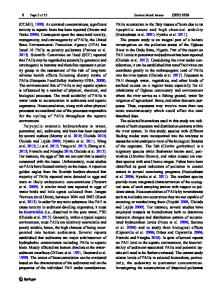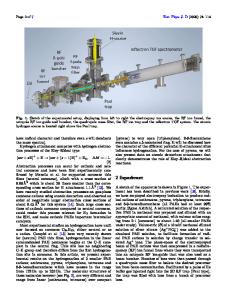Characteristics and source apportionment of polycyclic aromatic hydrocarbons of groundwater in Hutuo River alluvial-pluv
- PDF / 2,318,322 Bytes
- 10 Pages / 595.276 x 790.866 pts Page_size
- 64 Downloads / 402 Views
RESEARCH ARTICLE
Characteristics and source apportionment of polycyclic aromatic hydrocarbons of groundwater in Hutuo River alluvial-pluvial fan, China, based on PMF model Chaobin Ren 1,2 & Qianqian Zhang 3 & Huiwei Wang 3 & Yan Wang 1 Received: 5 August 2020 / Accepted: 29 October 2020 # Springer-Verlag GmbH Germany, part of Springer Nature 2020
Abstract PAH contamination in water environment has become an important water quality problem in China. In this study, groundwater PAHs were monitored in September 2019 at 48 groundwater sites, and statistical analysis and positive matrix factorization (PMF) model were used to analyze the characteristic of PAHs in groundwater and to identify the pollution sources of PAHs in the Hutuo River Basin, Hebei Province, China. The results showed that the concentration of the PAHs in groundwater was low and the total PAHs (∑PAHs) ranged from below detection limit to 260.6 ng/L and with a mean value of 17.7 ng/L. The concentration of PAHs in groundwater was obviously affected by the land use. Based on molecular ratio method, the main source of PAHs in groundwater is the biomass combustion, while the results of PMF source analysis were more accurate and the results showed that the primary sources and contribution rate of PAHs in groundwater were wood, coal, and gasoline sources (41.4%), followed by oil and diesel sources (39.4%), and natural gas combustion (19.2%). There was obvious spatial variation in the contribution of pollution sources to PAHs at the sites of different land uses in this region. The highest contribution of nature gas combustion, oil and diesel sources, and wood, coal, and gasoline combustion to PAHs was found in the urban area (0.617 ng/L), industrial area (0.380 ng/L), and village area (0.379 ng/L), respectively. The results can provide scientific basis for the prevention and control of PAH contamination in groundwater in this area. Keywords Groundwater . Polycyclic aromatic hydrocarbons (PAHs) . PMF model . Source apportionment
Introduction Polycyclic aromatic hydrocarbons (PAHs) are highly toxic persistent organic pollutants (POPs) widely existing in water, soil, and atmospheric environments and listed by international environmental protection agencies as priority pollutants due to their Responsible Editor: Xianliang Yi * Qianqian Zhang [email protected] Huiwei Wang [email protected] 1
School of Chemical Engineering, Zhengzhou University, Zhengzhou 450001, China
2
School of Civil Engineering, Nanyang Institute of Technology, Nanyang 473004, China
3
Institute of Hydrogeology and Environmental Geology, Chinese Academy of Geological Sciences, Shijiazhuang 050061, China
have the characteristics of carcinogenic, aberrance, and mutagenic characteristics (Carmichael et al. 1997). Recently, the PAH contamination in water environment has attracted wide attention from researchers (Chen et al. 2020; Davis et al. 2019; Liu et al. 2020; Montuori et al. 2016; Yang et al. 2013). After entering the water environment, PAHs are easily accumulated in the sediments.
Data Loading...











